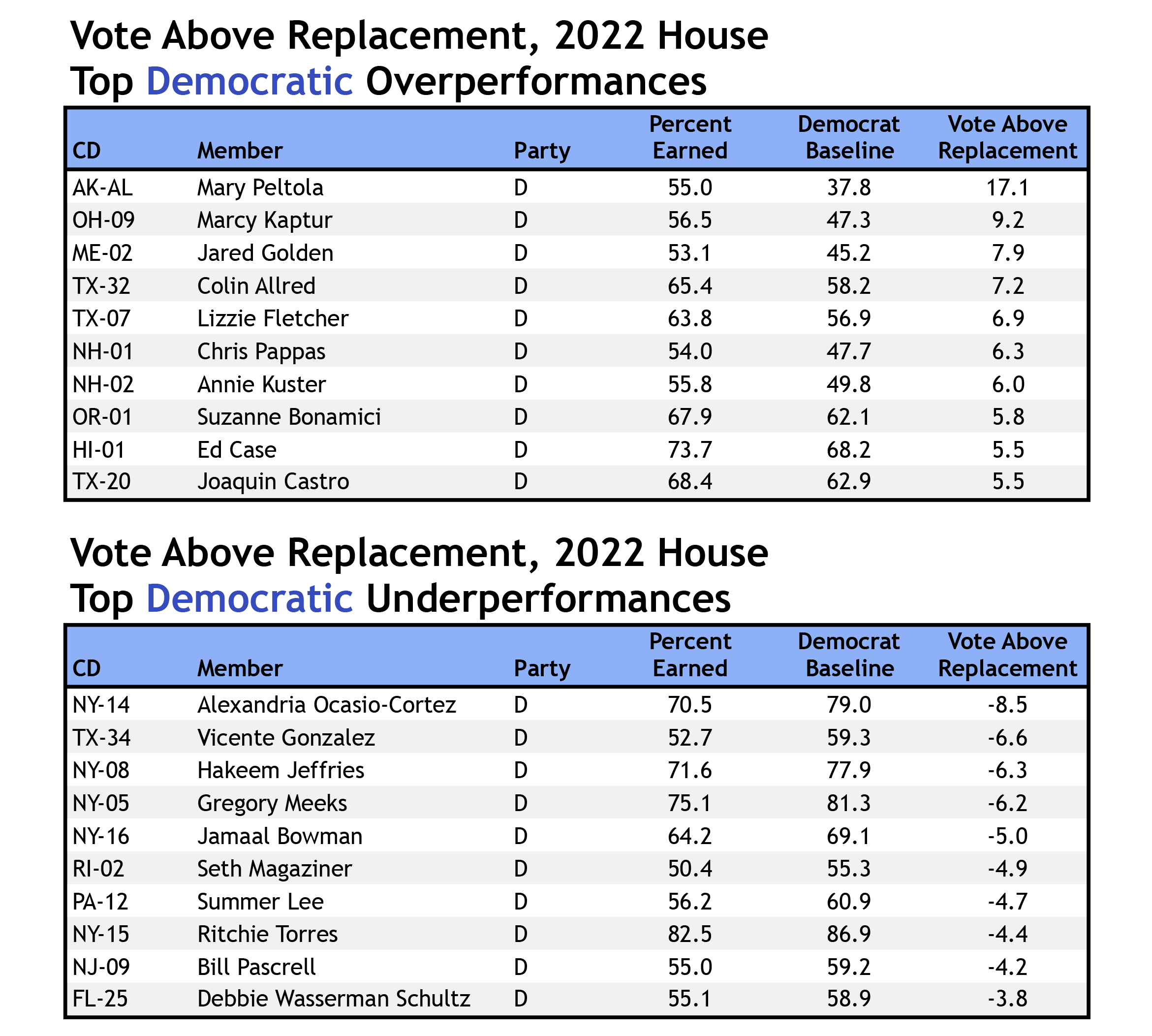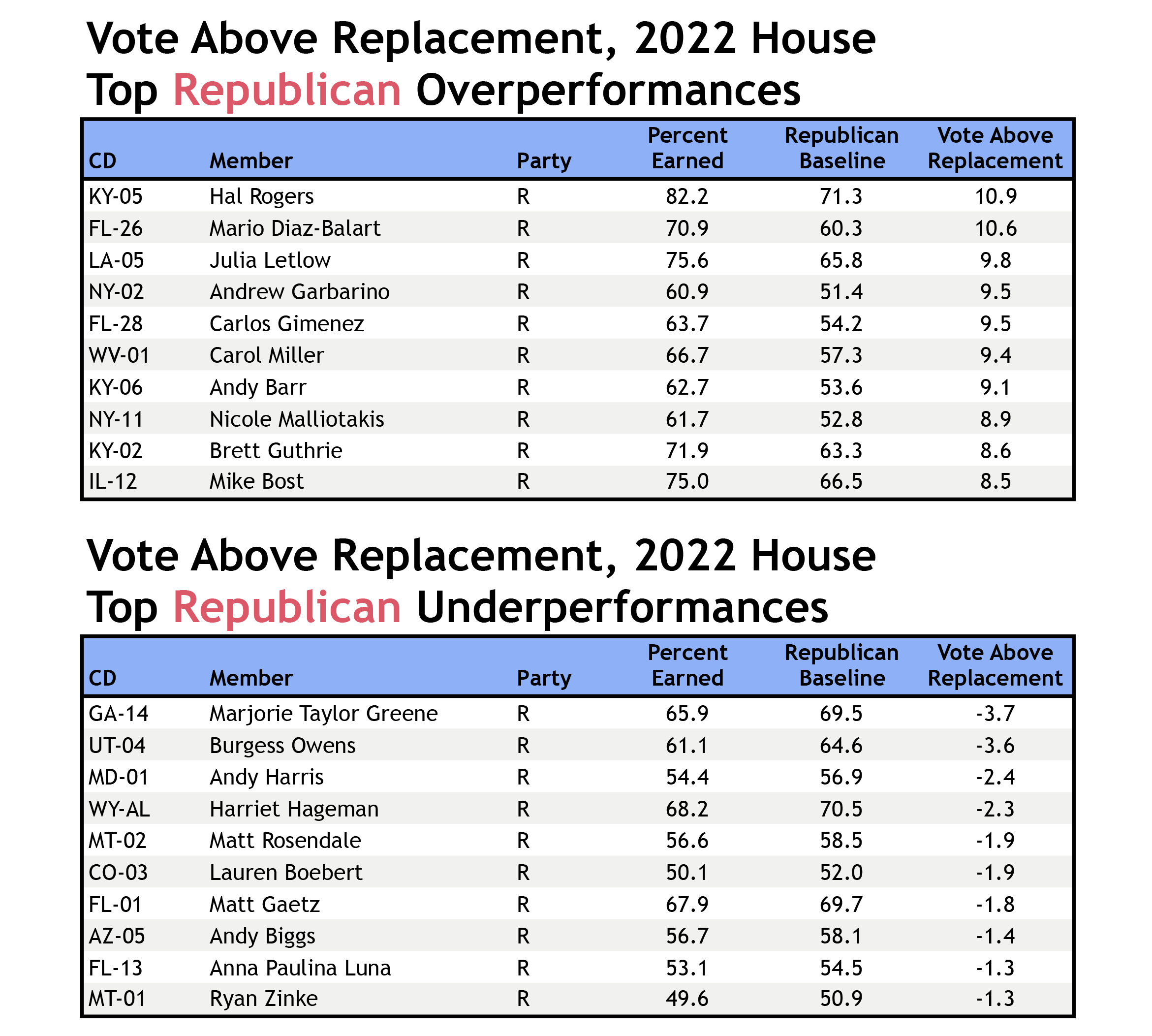Vote Above Replacement: 2022 House Elections
January 10, 2024 · 10:50 AM EST
Judging candidate performance is often a subjective and imprecise game.
Sure, you can clearly tell when a diamond is a diamond or a dud is a dud, but outside of these obvious outliers, the labels “strong” and “weak” have different definitions depending on who you ask. Particularly for House races, where public polls are less prevalent and district-level election results are harder to crunch, it’s common to compare a candidate’s performance to the previous congressional result or the most recent presidential race — if anything at all. But we can go deeper with Vote Above Replacement, or VAR.
Explore every House member's Vote Above Replacement here.
VAR measures the strength of a political candidate relative to a typical candidate from their party within the same district. That initial benchmark is derived using Inside Elections’ Baseline, which captures a congressional district’s political performance by combining all federal and state election results over the past four election cycles into a single score. VAR is simply the difference between a candidate’s share of the vote and their party’s Baseline. A higher VAR indicates a strong performance relative to expectations.
Across all House races in 2022 featuring one Democrat against one Republican (therefore excluding the 35 districts that went uncontested by either party), the average member-elect of Congress finished with a 2.2 VAR. Out of those 400, 312 (78 percent) earned a positive VAR — meaning they not only won their district, but outperformed a typical candidate from their party in the process. This tracks closely with our 2022 VAR calculations for the Senate, where 75 percent of members-elect finished in the green.
The fact that so many winners posted a positive VAR isn’t surprising. When comparing results between multiple election cycles, some amount of candidate “overperformance” could be chalked up to a state or district simply becoming more partisan over time. (For example, Baseline was slow to adapt to rapid polarization in states like West Virginia, leading to higher-than-expected VAR scores for many statewide Republicans.) But these effects start to wash away in the aggregate — and even through it all, incumbents continue to win re-election practically nine times out of ten, and Americans have long tended to disapprove of Congress while approving of their congressperson.
For other storylines unique to 2022, look at the VAR breakdown by party. The median Democratic member was elected with a 1.1 VAR. But the performance of the median Republican member (VAR: 3.5) was 2.4 points stronger — falling in line with the GOP’s 2.8-point margin in the national popular vote.
The best-performing candidate in 2022 according to VAR was Democratic Rep. Mary Peltola of Alaska’s At-Large District. She received 55 percent after ranked-choice votes were tabulated, which is 17.1 points higher than the Democratic Baseline of 37.8 percent. Her opponent, former GOP Gov. Sarah Palin, ran behind a typical Republican by 5.2 points (45 percent vs. 50.2 percent Baseline).
Members like Peltola will be pivotal to Democrats’ hopes of retaking the House in 2024 — but her success also hints at the party’s structural disadvantages. She is one of only five Democrats representing a seat won by former President Donald Trump in 2020; across those five members, the average Democratic overperformance in 2022 was 7.9 points. By contrast, the 18 Republicans in districts carried by Joe Biden only recorded an average 3.8 VAR. This suggests Republicans have more wiggle room in these competitive races — they're less reliant on large overperformances — and they might not need to dominate as many for a majority. Case in point: Arizona’s 1st District Rep. David Schweikert underperformed the typical Republican (VAR: -0.5) in a seat that is trending toward Democrats and still won by a point.

Republicans’ biggest overperformer also happens to be their longest tenured member. Kentucky Rep. Hal Rogers outpaced a typical GOP candidate in the 5th District by 10.9 points last cycle, and he has already announced plans to seek a 23rd term. But not everyone with a positive VAR is sticking around. North Carolina Rep. Patrick McHenry, who briefly served as House speaker pro tempore in October, would have outperformed a typical Republican in the 10th District by 3.8 points last cycle, but is retiring from Congress at the end of his term as chair of the House Financial Services Committee.
McHenry made his decision as the Tar Heel State prepares to use yet another new congressional map in 2024. Following an October decision from the state Supreme Court, the new lines heavily benefit Republicans, meaning many Democratic members are headed for the door. Reps. Wiley Nickel (VAR: 1.8) and Jeff Jackson (VAR: 3.2) have both chosen to not seek another term despite overperforming a typical Democrat in 2022, while 6th District Rep. Kathy Manning (VAR: -0.2) is also out. Jackson is instead running for attorney general; meanwhile in the 8th District, GOP Rep. Dan Bishop (VAR: 4.4) is surrendering his seat to seek the same statewide office.

There were also interesting patterns among Congress’ more recognizable personalities. Six members of the Squad finished in the red, and Rep. Alexandria Ocasio-Cortez — who is possibly the most well-known person in the entire House — recorded the lowest VAR (-8.5) of any winning congressional candidate in 2022.
Not to be outdone, Republican Reps. Matt Gaetz (VAR: -1.8), Lauren Boebert (VAR: -1.9), and Marjorie Taylor Greene (VAR: -3.7) also fell well short of their party’s Baselines. Boebert’s underperformance, which put her within 554 votes of losing altogether, likely factored into her decision to hop over to Colorado’s 4th District and avoid an expensive rematch with 2022 Democratic nominee Adam Frisch.
But not everyone can skip a repeat. Democratic Rep. Jahana Hayes (VAR: -0.9) and Republican Rep. Ryan Zinke (VAR: -1.3) both fell short of Baseline expectations last cycle despite winning in competitive districts — and they’ll likely face familiar foes in 2024. Hayes’ 2022 Republican opponent, former state Sen. George Logan (VAR: 2.3), is running again in Connecticut’s 5th District. And Zinke’s 2022 opponent, attorney Monica Tranel (VAR: 0.1), has thrown her hat in the ring a second time for Montana’s 1st.
Of course, these won’t be the only House rematches this November. An upcoming article will look in depth at the VAR scores of returning congressional challengers.